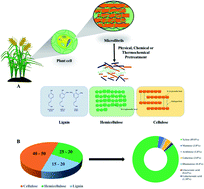Valorisation of xylose to renewable fuels and chemicals, an essential step in augmenting the commercial viability of lignocellulosic biorefineries
Abstract
Biologists and engineers are making tremendous efforts in contributing to a sustainable and green society. To that end, there is growing interest in waste management and valorisation. Lignocellulosic biomass (LCB) is the most abundant material on the earth and an inevitable waste predominantly originating from agricultural residues, forest biomass and municipal solid waste streams. LCB serves as the renewable feedstock for clean and sustainable processes and products with low carbon emission. Cellulose and hemicellulose constitute the polymeric structure of LCB, which on depolymerisation liberates oligomeric or monomeric glucose and xylose, respectively. The preferential utilization of glucose and/or absence of the xylose metabolic pathway in microbial systems cause xylose valorization to be alienated and abandoned, a major bottleneck in the commercial viability of LCB-based biorefineries. Xylose is the second most abundant sugar in LCB, but a non-conventional industrial substrate unlike glucose. The current review seeks to summarize the recent developments in the biological conversion of xylose into a myriad of sustainable products and associated challenges. The review discusses the microbiology, genetics, and biochemistry of xylose metabolism with hurdles requiring debottlenecking for efficient xylose assimilation. It further describes the product formation by microbial cell factories which can assimilate xylose naturally and rewiring of metabolic networks to ameliorate xylose-based bioproduction in native as well as non-native strains. The review also includes a case study that provides an argument on a suitable pathway for optimal cell growth and succinic acid (SA) production from xylose through elementary flux mode analysis. Finally, a product portfolio from xylose bioconversion has been evaluated along with significant developments made through enzyme, metabolic and process engineering approaches, to maximize the product titers and yield, eventually empowering LCB-based biorefineries. Towards the end, the review is wrapped up with current challenges, concluding remarks, and prospects with an argument for intense future research into xylose-based biorefineries.



 Please wait while we load your content...
Please wait while we load your content...